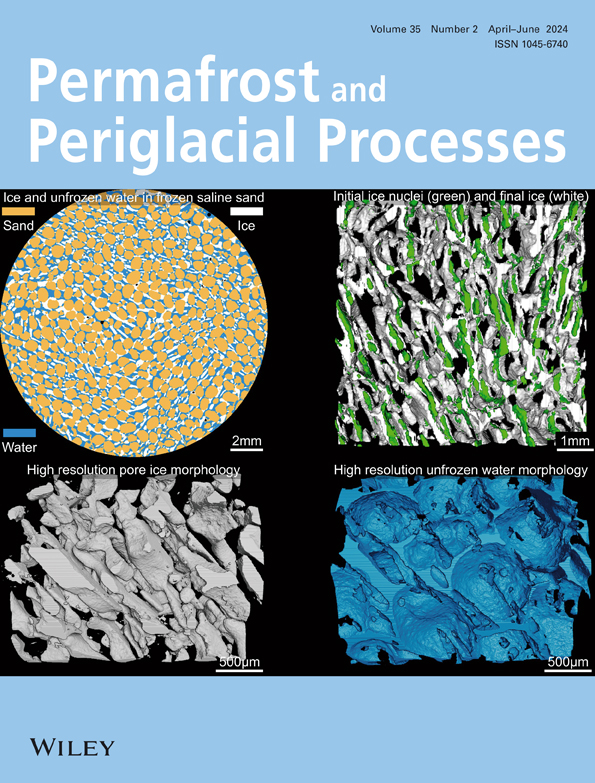Effects of thermosyphons on the thermal regime and stability of cast‐in‐place piles in permafrost regions on the Qinghai‐Tibet Plateau
IF 3.3
3区 地球科学
Q2 GEOGRAPHY, PHYSICAL
引用次数: 6
Abstract
The thermal effects of cast‐in‐place piles on the surrounding permafrost frequently induce deformation or failure of piles in permafrost regions. Because piles are directly inserted into the permafrost layer, the thermal disturbance of the piles is more straightforward than that of road embankments to the permafrost. Thermosyphons have proven to be effective in stabilizing the embankments of highways and railways in permafrost regions. However, the effects of thermosyphons on the thermal regime and stability of the cast‐in‐place piles remain unclear. The foundation soils of most piles in permafrost regions along the Qinghai‐Tibet Power Transmission Line were cooled by thermosyphons, and the results of a 7‐year‐period monitoring of ground temperature and deformation of a pile are presented in this paper. The results showed that the extent of thawed permafrost during the installation of the pile extended more than 5 m away from the pile. Thermosyphons shortened the refreezing time by more than 2 months. Thermosyphons cooled the surrounding permafrost to temperatures below the ambient ground temperature at the end of the cold seasons, and the temperature difference lasted until the end of the warm seasons owing to cold reserves formed in the cold season. The thermosyphons mitigated the thermal effects of the concrete pile owing to their higher thermal conductivity. Thermosyphons also significantly decreased the rate of active layer thickening around the pile compared to that observed in a natural field under a warming climate. Generally, thermosyphons stabilized the piles during the observation period by cooling the permafrost around the pile and producing a greater adfreeze force to counteract the frost heave force and subsequently support the tower. Additional thermosyphons or insulation measures may be necessary to ensure the long‐term stability of piles, considering a faster degradation of the ambient permafrost than expected. The results may provide insights into the design and maintenance of cast‐in‐place piles in warm permafrost regions.热虹吸对青藏高原多年冻土区灌注桩热状态及稳定性的影响
在多年冻土区,灌注桩对周围多年冻土区的热效应经常引起桩的变形或破坏。由于桩直接插入永冻层,桩的热扰动比路堤对永冻层的热扰动更直接。热虹吸已被证明在稳定永久冻土区公路和铁路的路堤方面是有效的。然而,热虹吸对灌注桩热状态和稳定性的影响尚不清楚。本文介绍了青藏输电沿线多年冻土区大部分桩的地基土采用热虹吸降温的方法,并对某桩的地温和变形进行了7年的监测。结果表明:桩基安装过程中,多年冻土融化范围向桩外延伸5 m以上;热虹吸使再冻时间缩短了2个月以上。在寒冷季节结束时,热虹吸将周围的永久冻土冷却到低于环境地温的温度,由于寒冷季节形成的冷储备,这种温差一直持续到温暖季节结束。热虹吸管由于其较高的导热性,减轻了混凝土桩的热效应。与在气候变暖的自然环境中观察到的情况相比,热虹吸管也显著降低了桩周围活性层增厚的速度。一般来说,在观测期间,热虹吸通过冷却桩周围的永久冻土,产生更大的冻结力来抵消冻胀力,从而支撑塔楼,从而稳定了桩。考虑到周围永久冻土的退化速度比预期的要快,可能需要额外的热虹吸或保温措施来确保桩的长期稳定性。研究结果可能为温暖的永久冻土区灌注桩的设计和维护提供见解。
本文章由计算机程序翻译,如有差异,请以英文原文为准。
求助全文
约1分钟内获得全文
求助全文
来源期刊
CiteScore
9.70
自引率
8.00%
发文量
43
审稿时长
>12 weeks
期刊介绍:
Permafrost and Periglacial Processes is an international journal dedicated to the rapid publication of scientific and technical papers concerned with earth surface cryogenic processes, landforms and sediments present in a variety of (Sub) Arctic, Antarctic and High Mountain environments. It provides an efficient vehicle of communication amongst those with an interest in the cold, non-glacial geosciences. The focus is on (1) original research based on geomorphological, hydrological, sedimentological, geotechnical and engineering aspects of these areas and (2) original research carried out upon relict features where the objective has been to reconstruct the nature of the processes and/or palaeoenvironments which gave rise to these features, as opposed to purely stratigraphical considerations. The journal also publishes short communications, reviews, discussions and book reviews. The high scientific standard, interdisciplinary character and worldwide representation of PPP are maintained by regional editorial support and a rigorous refereeing system.

 求助内容:
求助内容: 应助结果提醒方式:
应助结果提醒方式:


